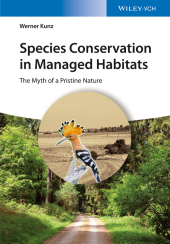 Neuerscheinungen 2016Stand: 2020-02-01 |
Schnellsuche
ISBN/Stichwort/Autor
|
Herderstraße 10
10625 Berlin
Tel.: 030 315 714 16
Fax 030 315 714 14
info@buchspektrum.de |

Werner Kunz
Species Conservation in Managed Habitats
The Myth of a Pristine Nature
1. Auflage. 2016. XVIII S. 9 Farbabb., 3 Tabellen. 244 mm
Verlag/Jahr: WILEY-VCH 2016
ISBN: 3-527-33845-4 (3527338454)
Neue ISBN: 978-3-527-33845-0 (9783527338450)
Preis und Lieferzeit: Bitte klicken
Dieses Praktikerbuch stammt von einem Autor mit langjähriger Erfahrung im Bereich der Ökologie von Insekten und Vögeln und einer herausragenden akademischen Laufbahn in den molekularen Biowissenschaften. Es ist eine willkommene Herausforderung und stellt die weitverbreiteten Ansichten herkömmlicher Umweltpolitik in Frage. Werner Kunz erläutert überzeugend, warum die Aufrechterhaltung einer großen Biodiversität in Europe ganz erheblich von offenen Flächen und karger Vegetation abhängig ist, d. h. Flächen, die weder intensiv nach Aspekten der modernen Landwirtschaft bewirtschaftet noch wieder aufgeforstet werden. Er stellt die weitverbreitete Meinung in Frage, dass Naturschutz mit Artenschutz gleichzusetzen sei, und zeigt, wie bedrohte Tierarten durch ein technisches Design des Lebensraums gerettet werden können.
Ein Muss für Umweltbehörden, politische Entscheidungsträger, Ökologen und alle, die Zeuge davon sind, wie aktuell in Zentraleuropa Arten verschwinden.
Written by an author with longstanding experience in the ecology of insects and birds and with a stellar academic record in molecular life sciences, this is a welcome challenge to the widely held beliefs in conventional environmental policies. Werner Kunz convincingly explains why maintaining high biodiversity in Europe depends heavily on the existence of open space and sparse ground vegetation that is neither used for intensive modern agriculture, nor eliminated by reforestation. He questions the commonly propagated opinion that nature conservation is equivalent to species protection - and shows that technical habitat design can rescue endangered species.
A must-have for environmental agencies, policy makers, ecologists and all who are witnessing the current loss of species in Central Europe.
Preface
Aims of the book
What is nature?
What is nature protection?
Mythos wood
Ideological burden of the idea of nature conservation
The prime objective of National parks in Central Europe is not rescue of endangered species
Threats to biodiversity in Europe differ from threats in other continents.
What makes Neozoa so special?
Regional Red lists of endangered species mainly aim at cultural heritage protection, not species protection.
Dramatic decrease of Central European bird and butterfly species during the last decades.
Conservation biology is not the same as species conservation.
Protection of the environment is not the same as species protection.
Military training grounds, industrial and urban areas as last refuges of endangered species.
Man as antagonist of nature.
Land sparing vs. land sharing (separation of areas for species from areas for agriculture)
Active manipulation of habitats as a solution against species extinction.
Winter feeding of birds and nesting boxes as interference factors of ecological equivalence
Golden Plover, Godwit and Great Bustard: examples of European breeding birds on manipulated habitats.
Who kills more birds: Mediterranean hunters or cats?
The importance of population genetics for species protection
List of species
Glossary
Currently a professor in Düsseldorf, Germany, Werner Kunz studied biology, chemistry, and physics in Münster and spent two postdoc years at Yale University in New Haven, U.S.A. Although he was educated as a zoologist, he switched to Drosophila genetics and worked on chromosomes and ribosomal DNA. He later changed his field of interest again, carrying out research into molecular parasitology, and for the past ten years has participated in the teaching of philosophy of science. Professor Kunz is currently continuing the hobby he began at a very early age, photographing birds and butterflies as a field biologist all over the globe.


